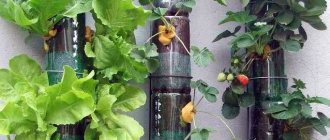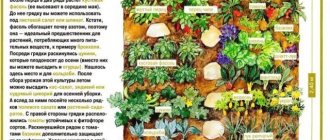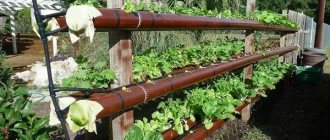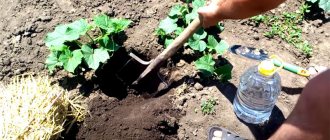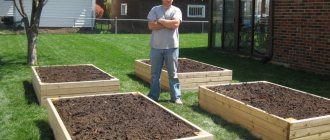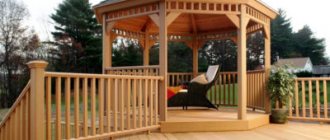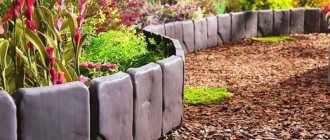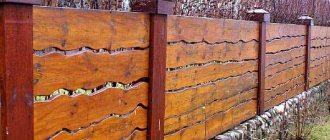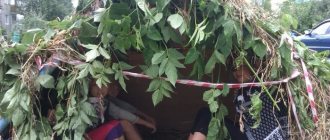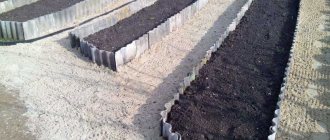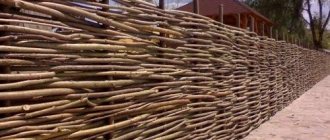Types of plastic fencing
For the manufacture of plastic fences, a special non-toxic polymer is used, which does not release harmful substances into the soil even when exposed to high temperatures. The material is resistant to temperature changes, so such fencing can be used in any climatic conditions. There are several types of plastic fencing.
Border tape
This is a polymer fence in the form of a flexible tape. Its width varies from 0.1 to 0.5 m, this allows you to choose the one that suits your needs - for fencing tall plants and shrubs, choose a wide tape, and for forming beds and zoning lawns - a narrow one. Advantages of border tape:
- Flexibility: with its help you can easily give the bed any desired shape.
- Protection of the embankment from erosion by water from heavy rains or during irrigation.
- Easy to install: just stretch the tape in a shallow trench and secure it with stakes.
- Mobility: if desired, next year the tape can be moved to another place, forming another bed.
- Ease of use: polymer tape is sold in rolls, so before installation you just need to cut the strip to the desired length.
- Variety of shades.
You can experiment with border tape if you purchase material of different widths and make a multi-tiered bed or flower bed. However, one drawback of this type of polymer fencing should be highlighted - that it cannot withstand heavy loads
Net
Plastic mesh is not usually used to create raised beds because the heavy soil is difficult to support. But for zoning a site, creating low beds, fencing flower beds, this is the best option. Unlike metal mesh, polymer mesh is lightweight, does not corrode, and is very easy to stretch. It is often used as an additional barrier when forming structures for beds made of other materials.
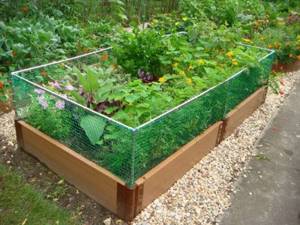
Plastic panels
These products will be a bright addition to your vegetable garden or garden. The panels can withstand high pressure from garden soil, retain water well, and are resistant to mechanical stress. Plastic panels are often used to form beds in greenhouses, as well as to create greenhouses. The width of the panels is usually 15 cm, but they can be used to build a high bed if you connect several pieces together. A fence for beds made of plastic panels is assembled very simply - using grooves and fastenings in the corners.

Garden constructor
This type of plastic fencing is a set of parts that are connected to each other in a certain way. The garden constructor is universal, and with its help you can assemble a garden bed of any size, both high and low fencing, and a multi-tiered composition of complex shapes. The design is quite simple to assemble; each package comes with instructions that describe the assembly process in detail.
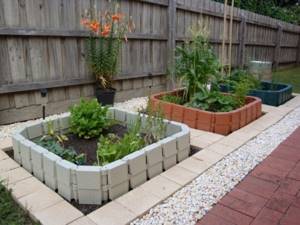
The garden constructor holds the mound well, as well as the moisture necessary for plants to grow and develop. The fence is lightweight, so there are no specific soil requirements for its installation; it can be installed in loose and loose soil.
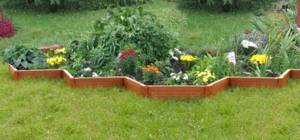
Plastic decorative fencing
Decorative polymer fences are distinguished by their unusual appearance: they imitate the natural textures of stone, brick, metal, forged openwork metal, colored picket fence, wicker, etc.
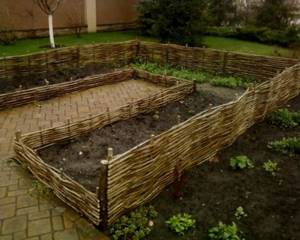
They are equipped with several elements that are assembled into a single structure. It can take on a complex shape, unlike panels and boards, therefore it is often used in landscape design, as well as for decorating fountains, flower beds, and lawns. They can be made not only in the form of panels, but also decorative flowers and other objects.
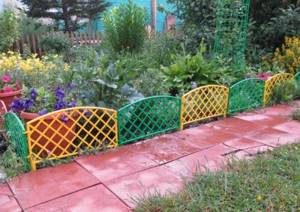
DIY fencing
Homemade plastic fences can be built using several options:
- plastic bottles;
- PVC window sills: if it is possible to obtain these panels as waste from the production of plastic windows, they will be an ideal option for fencing - the panels are durable and are not afraid of either atmospheric or mechanical influences, but there is one drawback - their cost;
- PVC siding panels;
- wide plastic panels used for finishing work are cheap, but not strong enough to support the weight of heavy soil.
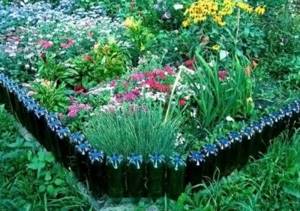
Plastic board
To make strong, durable and aesthetic fencing, plastic boards are used. They are distinguished from plastic panels by a more complex composition and longer service life.
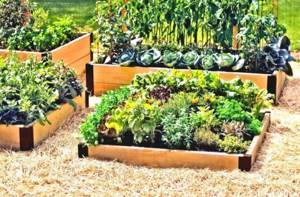
Features of plastic beds
Modern fencing designs have improved characteristics. The material is not afraid of high and low temperatures. Strong heating does not contribute to the release of dangerous toxic substances into the soil. The market for plastic fencing is represented by a wide range of products for arranging garden beds. The structures are in demand among site owners due to their affordable cost and practicality. Plastic is not afraid of corrosion, rotting, or insect pests. Let's consider all the features and advantages of using artificial material over traditional wooden boards, stone, and metal.
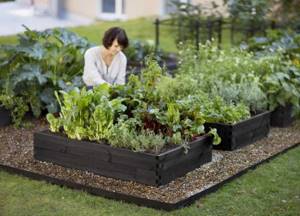
Plastic products are versatile due to their properties:
- practicality - their low weight allows them to be installed even on loose soils;
- unlimited height of sides - by adding tiers you can add the required layer of fertile soil;
- resistance to corrosion, humidity, aggressive environmental influences, significant temperature changes;
- durability - retains its original appearance for decades;
- a wide range of options for arranging beds - from simple rectangular to unusual curved shapes;
- aesthetic appearance;
- high-quality atmospheric plastic does not lose color or shape from exposure to sunlight;
- wide scope of application - landscape design, zoning, decor, highlighting sidewalks or garden beds, adding accents;
- harmlessness – does not release substances into the ground that can disrupt the mineral balance of the fertile layer;
- low price;
- ease of installation - you can install it yourself;
- ease of dismantling if necessary;
- mobility, repeated use possible.
Plastic fencing retains moisture inside the bed as much as possible.
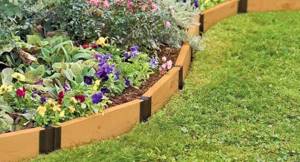
The new material is gradually replacing the widely used wood. Polymer beds can be installed in any climate zone. They do not melt or fade in the sun, and do not crack from frost. Lightweight practical material allows you to freely imagine, creating various shapes. It holds its shape remarkably well and does not allow soil to leak out. This means the area will be clean. The fencing elements are easily connected. Even a fragile woman can handle the installation. Unlike wood, the structure does not require additional care. You can clean the plastic from dirt using a garden hose without dismantling the bed. You can install border panels not only in open ground, but also create areas for planting plants in greenhouses. Due to the light weight and compactness of the elements, they are easy to transport. A border buried in the ground creates an obstacle for weed roots to penetrate into fertile crops.
Installing plastic borders allows you to reduce the digging area and reduce fertilizer consumption. Only the soil within the perimeter of the bed can be processed.
Thanks to all these advantages, a wide choice of colors and designs, plastic beds are very popular among flower growers, gardeners, and summer residents.
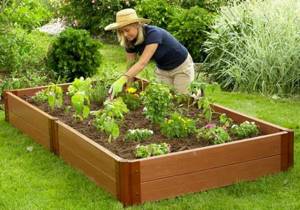
Characteristics of garden plastic board
It’s not for nothing that a plastic board got its name: it has the texture of wood and is made on the basis of a wood-polymer composite. It is made from wood waste with a binder - a polymer. During their connection, polymerization occurs, and further extrusion makes it possible to form WPC boards from the molten mass. The plastic boards are completed with hinges connecting the panels and stakes, with the help of which the finished box is secured in the ground. Using stakes, you can increase the height of WPC fences.
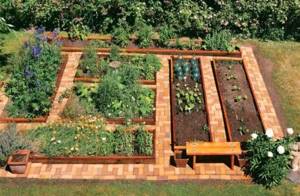
Pros and cons of using a plastic board
The use of plastic boards has many advantages:
- Durability: unlike ordinary wood, which rots in the ground from constant exposure to moisture, the polymer composite is not subject to destruction from water or drying out.
- Aesthetic appearance: beds made of plastic boards look very neat and attractive, imitating natural wood, but without the inherent disadvantages that arise over time - loss of color, damage to the structure, etc.
- Boards based on a polymer composite can be purchased in any color scheme that will not lose its saturation over time.
- Easy to install and dismantle the barrier using a special fastening system.
- Possibility of creating beds of any desired shape and size.
- Durable board surface: the dense structure is resistant to various mechanical influences.
- The smooth surface does not cause dirt to accumulate on the boards, so they do not require special care. Good thermal conductivity of WPC panels.
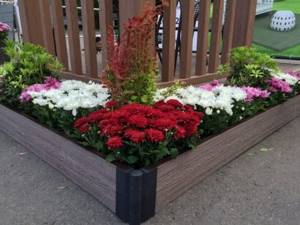
Despite the fact that WPC-based boards may cost more than some types of wood, unlike wooden fences, they do not require special care, coating with protective agents, or replacement due to destruction throughout their long service life (10 years or more), therefore we can talk about saving money when building beds from plastic boards. One of the disadvantages is the fact that with prolonged contact with water, mold may appear on the boards.
Ideas for beds made of plastic boards
Plastic beds leave room for imagination. A plastic corner, or clamp, connecting two boards at the end allows you to change the angle of the bed. Using it, you can change the height of the fence, connecting the corners to each other and creating original, multi-tiered compositions.
Types of beds
Due to the assembly features of plastic fencing, they can take on a variety of shapes. Types of beds made of plastic boards:
- Rectangular: a classic design that fits any size area.
- Square: beds of this shape are conveniently located in the corners of the site.
- Triangular: embankments of this shape are convenient to place on irregularly shaped areas. Additionally, triangles with vegetation are a great way to decorate your landscape.
- Multi-tiered: an excellent option for placing in a small area, as well as decorating it.
- If the garden is spacious, you can show your imagination and form beds of unusual shapes, for example, in the form of polygons.
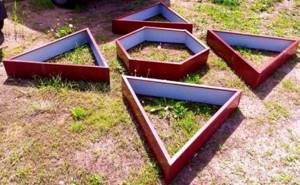
Advantages of plastic panels for beds
Options for designing beds
Such panels have a number of advantages that distinguish them from other types of borders.
- First of all, the atmospheric plastic from which street fencing is made is impervious to temperature changes. Thanks to this, borders can be safely used regardless of climatic conditions.
- The cost of such products is low (for example, a three-meter “garden set” with a height of 21 cm costs about 800 rubles, and a border strip measuring 0.12x15-3000 cm costs about 950 rubles).
- Plastic is a non-natural material, which means it does not decompose, does not fade under UV rays, and mold does not develop on it. It is all this that determines practicality and durability.
- This material is also quite durable, it holds its shape well, so it can be used for beds of a wide variety of shapes.
In the photo there are oddly shaped beds with plastic fencing
Thanks to all these advantages, plastic fencing is very popular among gardeners and flower growers.
Where can I buy a plastic board, price
Fencing for garden beds made of plastic boards can be purchased at any hardware or hardware store that sells materials for gardening. In addition, there are many online stores where you can buy not only boards with fastenings separately, but also a ready-made structure of any shape.
It is convenient to buy boards separately when you need to make a bed of a certain size and shape. The average price of a board measuring 3mx15cm per piece is 850-900 rubles, the cost of a shorter board is half the price - 450 rubles. per panel 1.5mx15cm. The price for a universal connecting element (rotary) is on average 240-250 rubles/piece. It is joined in height and the rotation angle ranges from 60 to 270 degrees. In addition, you will also need a corner metal element to strengthen the connections - it costs 220 rubles per piece.
The cost of a finished bed depends on its size and shape. Thus, the average cost of a classic rectangular bed measuring 1mx2mx0.15m is 2700-3000 rubles. The price of a three-meter structure varies from 3,000 to 10,000 rubles, depending on the height of the sides and its width. The cost is also influenced by the choice of manufacturer.
What can plastic beds be made from?
Plastic garden beds can be made from a variety of materials. Only polymers that are too soft and flexible are not suitable for creating a fence.
An example would be a plastic fence for a flower bed made from ordinary bottles. The material is almost free and very easy. Insufficient mechanical strength is compensated by filling the bottles with earth or sand. If desired, you can paint it to make the plastic bed more attractive. Such a fence can be given any configuration.
There are many other solutions.
Fencing for garden beds made of plastic boards
Plastic boards for beds are the best solution to this issue. The material for it is wood-composite plastic. During manufacturing, sawdust is mixed with a polymer composition and then cast in the form of a board. Polyethylene, polyvinyl chloride, and polypropylene are used as the polymer component. PVC boards are considered the most resistant and durable, and those that contain polyethylene wear out faster.
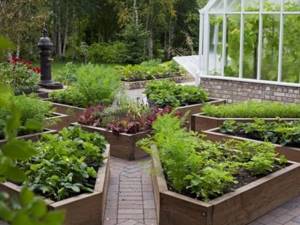
This product combines the advantages of wood and plastic:
- Composite plastic boards do not rot like wood and are insensitive to ultraviolet radiation like plastic ones; such fencing has the longest service life;
- due to its resistance to any type of corrosion, the plastic bed does not require any maintenance or periodic painting or priming;
- boards are produced in a wide variety of colors and with any texture; the shade and pattern do not change over time;
- this is a fully collapsible plastic bed, since the structure can be assembled and dismantled as many times as you like;
- Composite plastic boards are characterized by exceptionally high strength and resistance to mechanical damage; for high beds, dense or unstable soil this is the best solution;
- plastic boards allow you to build flower beds of any size and configuration; they are inferior in flexibility to border tape, but still allow you to create curved, smooth contours;
- the surface of the product is smooth, not prone to dirt accumulation and very easy to clean;
- Wood-plastic boards have good thermal conductivity.
The only disadvantage of the product is its higher cost compared to other options. In addition, just like pure plastic boards, composite material is not suitable for wetlands and lowlands.
The products can be assembled using either a regular mount or plastic corners or clamps. The latter option is more practical: it makes it easier to disassemble the bed. In addition, when assembling with clamps, you can arbitrarily change the height of the fence and the angle of rotation.
Fencing for garden beds made of plastic window sills
Plastic window sills are an unusual, but quite popular solution. This product is attractive for its durability, convenient shape and guaranteed safety. Since the window sill is designed for use inside the house and is almost always exposed to sunlight, it is made of special resistant plastic and without life-threatening stabilizers.
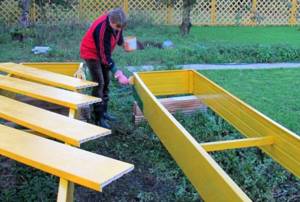
The width of window sills varies within extremely wide limits. If necessary, they can be used to build even very high beds. Such borders for plastic beds are fastened with ordinary self-tapping screws or even nails.
Fences made from plastic window sills have the following advantages:
- high quality plastic and its safety for human health;
- guaranteed very high resistance to ultraviolet radiation;
- extremely wide selection of sizes;
- mechanical strength, such a fence can withstand the pressure of both dense and loose soil;
- A plastic bed made from window sills is not susceptible to rotting or mold.
This option also has disadvantages:
- the design is non-removable, the fasteners damage the window sill, after dismantling, fragments with holes from the fasteners should be cut off, only in this case the window sill can be used again;
- the cost of the material is quite high.
For fencing, you can use not only standard white window sills, but also those that imitate wood or even stone. This type of fence is much more decorative.
Fencing for garden beds made of PVC panels
The greatest choice in terms of decorative finishing is construction plastic panels. Since they are used very often for cladding, almost any dacha owner will have several meters of unneeded finishing boards. It can be used as a fencing material.

The advantages of such a fence are as follows:
- borders for beds made of plastic panels can imitate a wide variety of materials and provide a huge selection of colors and textures;
- This is a practically free option;
- plastic panels are safe for health, as they were originally designed for use inside or outside the house;
- ants hate the smell of plastic, so the owner will never find anthills in the garden bed;
- are little susceptible to mold and fungi, and are not afraid of rain and snow.
How to calculate the required material
The need for material for making a bed depends on its size, shape, and number of corner joints. For example, to make beds from a board 3 m long, 1.25 m wide and 25 mm high, you will need the following material:
| Bed size, m | Number of boards across the width of the bed | Number of boards by length | Number of corner connections |
| 3mx1.5m | 2 pieces 1.5 m each | 2 pcs (3m) | 4 things |
| 3mx1m | 2 pcs 1m each | 2 pcs (3m) | 4 things |
| 2mx1m | 2 pcs 1m each | 2 pcs (3m) | 4 things |
| 1mx1m | 2 pcs 1m each | 2 pcs 1m each | 4 things |
Considering that many manufacturers produce boards 3 meters long, there will be excess left over when making the beds. For the manufacture of complex structures, the number of corner joints increases.
What to look for when purchasing
To ensure that a WPC board lasts a long time, you should pay attention to several important points when purchasing:
- Manufacturer's choice. Today, WPC boards are presented on the market from manufacturers in Russia, China, and European countries. When choosing products, you need to remember that high-quality imported WPC cannot cost less than Russian ones due to delivery costs and various customs duties.
- When purchasing, be sure to check whether the product has a quality guarantee from the manufacturer. This factor speaks not only about the quality of the material, but also about the reliability of the manufacturer.
- An indicator characterizing the quality of a board is the raw material from which it is made. Often, instead of “primary” polymer, panels are made from “secondary” polymer, i.e. cheaper raw materials that are reusable. To be aware of quality, you need to study the product documentation in detail.
- The type of binder polymer may affect the performance of the board. PVC, polyethylene or polypropylene can be used as such polymers in the manufacture of boards. PVC is more expensive, but it is more wear-resistant and durable. Boards with polyethylene in their composition are cheaper, but wear out faster.
- Board composition: the content of polymer and wood component in a ratio of 50/50% makes the product wear-resistant, but many manufacturers reduce the cost of products by reducing the content of the polymer composition. If the share of wood component is more than 50%, such panels wear out faster.
- When purchasing a board, you should keep in mind that during the first time after production, its shade may be darker or lighter than stated. However, if it has been stored in a warehouse for more than 2 weeks, its color should no longer change.
- Manufacturers of WPC-based boards claim the environmental safety of their products, but when choosing a material, it doesn’t hurt to make sure there is a hygienic certificate.
- The correct geometry of the product indicates the ability to withstand loads.
When purchasing, you need to pay attention to the cut. It should be homogeneous, even, without chips or separated fibers.
How to install a plastic border yourself
The plastic board for beds contains all the necessary elements for installation. Stages of making a border:
- Plastic fences for beds are cut into pieces of the required length in accordance with the size of the future embankment.
- The panels are fastened to each other in a seamless manner, and care must be taken to ensure that there are no gaps between them.
- At the corners, the boards are attached to special pegs. The panels can be fixed at any angle, but the minimum acceptable value is 60 degrees. Corner supports should exceed the height of the top edge of the fence by 0.2 m, and internal posts by 0.5 m.
- The area for the garden bed is carefully leveled and the turf is removed. After preparing the soil, you can begin installing the box.
- The assembled frame is transferred to the prepared area, the structure is aligned diagonally. Then they determine the installation location for the corner supports, and also set up the internal, intermediate posts.
Assembling a plastic bed is not difficult due to the fact that such structures are sold almost ready-made; all that remains is to connect all the elements together.
How to make plastic beds with your own hands
Plastic products are a very convenient material. It is lightweight, easy to cut, bend and fasten with almost any type of fastener. The construction of plastic fences for flower beds and beds does not take much time.
How to make raised beds from plastic boards with your own hands
Wood-plastic boards or rigid plastic panels are the most popular solution. The technology for making a fence from these materials is almost the same.
You will need boards, logs that are used as posts, corners for assembly and fasteners. You will also need decorative plugs to cover the holes at the joints.
- Plastic boards are cut to the size of the future flower bed or bed. This takes into account the need to join the panels.
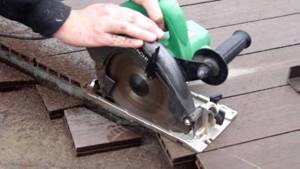
- Support posts are cut: the height of each should exceed the future fence by 20 cm. The boards are fastened with corners - special or metal. The first allow you to create a connection at any angle. The structure is fixed on corner posts so that 20 cm of height is not at the top, but at the bottom of the fence. The hole is closed with plugs.

- Boxes for beds made of plastic panels are then transferred to the area where the bed is formed, deepening the frame into the ground using support posts. Then intermediate columns are placed. The boards are secured to them with self-tapping screws.
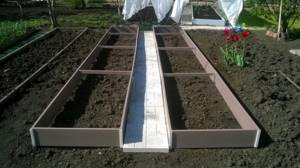
If desired, the finished product can be painted or varnished.
How to make beds from plastic window sills with your own hands
Edging the beds with plastic from window sills is done using almost the same technology. In this case, seamless fastening is not expected; metal corners and fasteners are needed for fixation.
- Window sills are cut to size. The edges of the products are cut at 45 degrees.
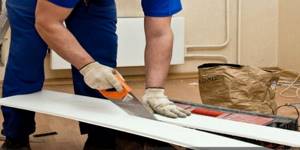
- Holes for bolts are made in the metal corners. Then the window sills are connected at an angle so that the metal corner is inside the joint. From the outside, holes are drilled in the plastic itself, and then the structure is secured with bolts.
- To ensure higher resistance to pressure, the sidewalls are fastened with studs. The step between them is 1 m.
